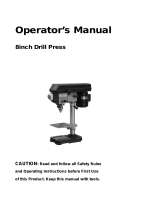Craftsman 113213100 Owner's manual
- Category
- Power universal cutters
- Type
- Owner's manual
This manual is also suitable for
Craftsman 113213100 is a motorized 8-inch bench model drill press with a maximum developed 1/3 HP motor. It is a versatile tool that can be used for a variety of drilling tasks, including drilling holes in wood, metal, and plastic. The drill press has a number of features that make it easy to use, including a variable speed control, a depth stop, and a keyless chuck. The variable speed control allows you to adjust the speed of the drill bit to match the material you are drilling.
Craftsman 113213100 is a motorized 8-inch bench model drill press with a maximum developed 1/3 HP motor. It is a versatile tool that can be used for a variety of drilling tasks, including drilling holes in wood, metal, and plastic. The drill press has a number of features that make it easy to use, including a variable speed control, a depth stop, and a keyless chuck. The variable speed control allows you to adjust the speed of the drill bit to match the material you are drilling.




















-
 1
1
-
 2
2
-
 3
3
-
 4
4
-
 5
5
-
 6
6
-
 7
7
-
 8
8
-
 9
9
-
 10
10
-
 11
11
-
 12
12
-
 13
13
-
 14
14
-
 15
15
-
 16
16
-
 17
17
-
 18
18
-
 19
19
-
 20
20
-
 21
21
-
 22
22
-
 23
23
-
 24
24
-
 25
25
-
 26
26
-
 27
27
-
 28
28
Craftsman 113213100 Owner's manual
- Category
- Power universal cutters
- Type
- Owner's manual
- This manual is also suitable for
Craftsman 113213100 is a motorized 8-inch bench model drill press with a maximum developed 1/3 HP motor. It is a versatile tool that can be used for a variety of drilling tasks, including drilling holes in wood, metal, and plastic. The drill press has a number of features that make it easy to use, including a variable speed control, a depth stop, and a keyless chuck. The variable speed control allows you to adjust the speed of the drill bit to match the material you are drilling.
Ask a question and I''ll find the answer in the document
Finding information in a document is now easier with AI
Related papers
-
Craftsman 113.213853 Owner's manual
-
Craftsman 113.213130 Owner's manual
-
Craftsman 113.213170 Owner's manual
-
Craftsman 113.213213 Owner's manual
-
Craftsman 113.213843 Owner's manual
-
Craftsman 113213151 Owner's manual
-
Craftsman 113213090 Owner's manual
-
Craftsman 113213850 Owner's manual
-
Craftsman 137219100 User manual
-
Craftsman 137.229201 Owner's manual
Other documents
-
Stark 53501-H1 User manual
-
 Boye MEDR3000 User manual
Boye MEDR3000 User manual
-
KNOVA KN DP-2000 Owner's manual
-
RIDGID DP15501 User manual
-
Hitachi B 16RM Instruction Manual And Safety Instructions
-
King Canada KC-108N User manual
-
Porter-Cable PCXB620DP User manual
-
Porter-Cable PCB660DP TYPE2 Installation guide
-
Porter-Cable PCXB620DP User manual
-
King Canada KC-122FC-LS User manual




























